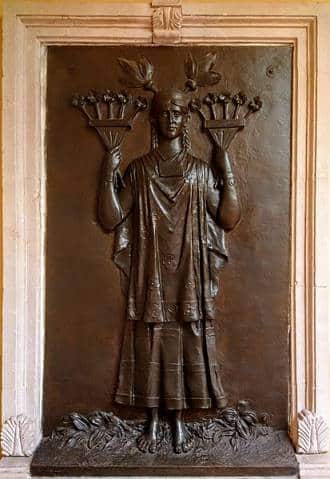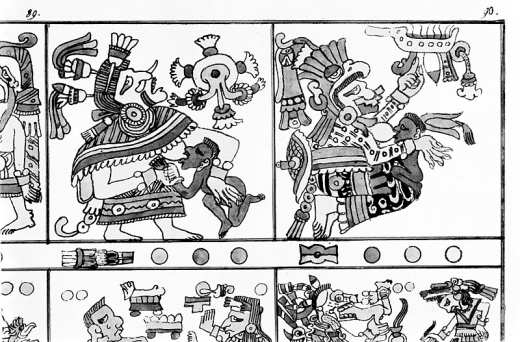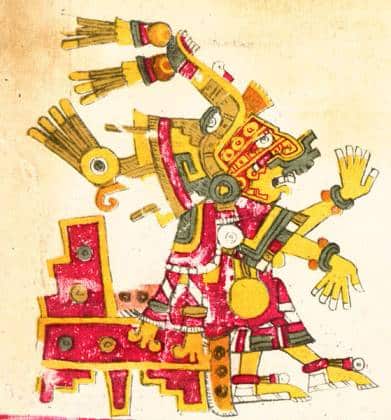Many Aztec goddesses were, at the same time, providers and destroyers. This duality was probably the reflection of living conditions during the Aztec Empire. Things that gave life, such as water and sun, could also easily kill you.
However, there is one Aztec goddess that was always benevolent, and she brought pleasure and happiness to her worshippers. Her name is Xōchiquetzal, and she is the goddess of love, beauty, flowers, and fertility, and she is the protector of young women.
Xōchiquetzal Origins
Just like other Aztec goddesses, Xōchiquetzal can be found as mentioned in old medieval and Precolumbian manuscripts, such as Codex Borgia, Codex Borbonicus, Codex Ríos, and the Florentine Codex. These manuscripts were mostly pictorial, which means they mostly consisted of pictures instead of text.
In those manuscripts, Xōchiquetzal was shown as a beautiful young woman wearing rich garments and surrounded by lush vegetation, flowers in particular. It is worth noting that other Aztec deities, even those that were associated with fertility and reproduction, just like Xōchiquetzal, were portrayed to look much more intimidating than this goddess.
Xōchiquetzal’s name is also quite interesting. It actually comes from two Nahuatl words: Quetzalli, which means a bird with splendid feathers, and Xóchitl, which means flowers. Another name for this beautiful goddess was Ichpochtli, which means “young girl” or “maiden.”
Xōchiquetzal has a twin brother, Xochipilli, a god of art, erotic love, beauty, and dance. Xochipilli is also a patron of homosexuals and male prostitutes.
Xōchiquetzal Creation Myths
Although there are some legends about the exact Xōchiquetzal origins, none of them is spread widely enough to be the “official” version of the events. However, it is well-known that Xōchiquetzal is one of the oldest Aztec gods.
It is also known that Xōchiquetzal came from Tamoanchan, the ancestral origin place of Aztec gods. When the gods Xipe Totec, Tezcatlipoca, Quetzalcoatl, and Huitzilopochtli created the universe, they also created the first man and woman. The first humans had a son, but when he grew up, there was no woman for him.
To solve this issue, the four gods created the second woman out of the hair from Xōchiquetzal’s head. This story further proves the claim that Xōchiquetzal was one of the first gods, but still, her origins remain speculated.
Xōchiquetzal’s Complicated Love Life
If your love life is a mess, and you wonder if there is something wrong with you, try to find consolation in the fact that Xōchiquetzal had the same issues as you. Her love life was… complicated, for lack of a better word. You can say it was expected, given that she was a goddess of love and pleasure, after all!
According to one legend, Xōchiquetzal was created from two hair strands from her husband, Piltzintecuhtli, a god of healing, visions, and the rising sun. However, she was also later married to Tlaloc, a god of rain.
But that obviously wasn’t enough drama, so Tezcatlipoca, a god of the night sky, hurricanes, the earth, and many other things, decided to kidnap Xōchiquetzal and make her his wife. After all, who could blame him?
Xōchiquetzal was also married to Centeotl, the god of maize, and Xiuhtecuhtli, the god of fire. However, some legends claim that Centeotl, also known as Cintéotl, was Xōchiquetzal’s son instead of a husband. Another god, Quetzalcoatl, is also claimed to be Xōchiquetzal’s son.
Goddess of Pleasure
Xōchiquetzal was a goddess that certainly knew how to enjoy herself, and she wanted to share all the pleasures with humans. As a goddess of love, she was the patron not only of romantic love but also the patron of sexual love and sexual relations.

As such, she protected lovers, prostitutes, and adulterers without judging or punishing them for their sins in any way. Additionally, Xōchiquetzal was known for being eager to forgive sins. It can be said that Xōchiquetzal was one of the first icons of sexual liberation.
She was also a patron of weavers and other craftspeople, as they could produce beautiful objects that caused pleasure for their observers. Since Xōchiquetzal was a goddess of pleasure, it is logical that she highly appreciated such crafts.
Xōchiquetzal was also often depicted adorned with flowers, which is fully expected, as flowers are beautiful, and she is the goddess of beauty. However, for Aztecs, as well as for many other cultures, flowers symbolize the clitoris and vulva, which gives a whole new dimension to why Xōchiquetzal is surrounded by them so often.
Xōchiquetzal, Pregnancy, Moon, and Spindle
Apart from being the goddess of beauty, pleasure, and crafts such as weaving, Xōchiquetzal was also associated with fertility and pregnancy. Interestingly enough, there are some fascinating ties between these concepts ruled by Xōchiquetzal.
For example, there is a strong symbolic connection between pregnancy and weaving. If you don’t think it is obvious, look at a spindle. As the weaver works, the spindle becomes rounder, just like the woman becomes rounder as her pregnancy progresses.
Similarly, Xōchiquetzal is also associated with the moon, which is always closely connected to the woman’s menstrual cycle, fertility, and pregnancy. Just like a pregnant woman becomes more rounded during pregnancy, the moon becomes rounded during its monthly cycle.
Xōchiquetzal And Other Aztec Deities
Apart from marrying several gods, Xōchiquetzal was associated with other Aztec deities too. For example, she was often compared to the goddess Tlazoltéotl, who ruled sexual excess and childbirth.
Xōchiquetzal was also compared to Chalchiuhtlicue, a goddess of freshwater streams. They were sometimes considered so similar that Xōchiquetzal was depicted in the same manner as Chalchiuhtlicue, with water flowing out of her body.
These parallels and comparisons shouldn’t be surprising, as all three goddesses (and several other Aztec deities) represented fertility. While other cultures had one or two fertility gods, Aztecs had several.
Xōchiquetzal’s Counterparts in Other Religions
One thing that never stops fascinating me is how similar cultures from different locations and time periods are. Two different civilizations might have lived on two different continents and in different time periods, and they would still have similar deities, traditions, and beliefs.
The archetype of the goddess of love, beauty, and fertility existed in many civilizations. For Eurocentric cultures, probably the most famous goddesses of life, beauty, and fertility were Aphrodite (Greek) and Venus (Roman).
In Norse mythology, Freya was what Xōchiquetzal was for the Aztecs. Slavs had Lada, Celts had Branwen, Hindus had Parvati, and Egyptians had Hathor. If we went through more civilizations and their pantheons, we would find even more goddesses that ruled over beauty, love, and fertility.
Xōchiquetzal’s Festivities
Since she is the goddess of fertility, Xōchiquetzal was usually celebrated during the harvest season. People would invoke her to ensure a bountiful harvest. There were actually several festivals and separate celebrations dedicated to Xōchiquetzal throughout the year.
Some of the most renowned of these festivals are Atamalqualiztli, Tepeílhuitl, and Xochíhuitl. Atamalqualiztli was an especially popular festival that was held every eight years. For eight days during the fall, the great city’s temple would become the epicenter of various activities.
The temple, trees, and wooden poles were adorned with roses and other beautiful flowers. People ate tamales (corn cakes) made only of water and corn flour. Children were dressed as hummingbirds and butterflies and running around between flower-adorned structures, pretending to suck the sweet pollen nectar.
The priests would later enter the scene, dressed as various gods. They would “chase” the children until the main festival attraction, Xochiquetzal, arrived. Of course, that was usually a young woman dressed in flowers and colorful skirts.
“Xochiquetzal” offered each of the “gods” with the incense and a garland of roses she carried around. After honoring each god, Xochiquetzal would sit amid flowers, trees, and bushes, while the celebration continued. People would dance around her, symbolizing the sexual union between flowers and birds and butterflies that pollinated them, contributing to the bountiful harvest.
A Ritual of Forgiveness
As mentioned before, Xochiquetzal was always eager to forgive every sin, no matter what it was. There was even an interesting ritual, usually performed around harvest time, that was aimed at asking for forgiveness of sins.

During that time, men and women would flock to Xochiquetzal’s temple, where they would confess to various sins and crimes. However, the ritual didn’t end there; it had just started, actually. Each person had to bring several straws with them. The number of straws corresponded to the number of that person’s sins.
After confessing the crimes, men and women entered the temple. Temple priests would pierce the tongues of each man and woman. Then, those men and women would pass their straws through the tongue hole one by one and then throw them on the floor.
Once everyone threw away their straws, the priests would collect the bloodied straws and burn them. People who confessed their crimes and went through the ritual were now absolved of their sins and could return to their homes, where they would purify themselves by bathing in rivers and streams.
Xōchiquetzal and Christianity
Modern scholars and experts in Mesoamerican cultures believe that Xochiquetzal can be identified with the Virgin of Ocotlan, a patron saint of the town of Tlaxcala.
Xochiquetzal is often seen as a symbol of sexual liberation, which isn’t really compatible with Catholic beliefs. Still, even though she had multiple marriages and several children, Xochiquetzal is still portrayed as a young woman with maiden-like features.
This perspective of looking at Xochiquetzal is much more in accordance with the Catholic religion, and it opens up the possibility of syncretizing Xochiquetzal with various saints based on the Holy Mary, a figure who is both motherly and virginal.
Still, some other Christian scholars compare Xochiquetzal to Eve, as they were both the first women that sinned. In one Aztec legend, the first sin ever was when Xōchiquetzal seduced her brother Yappan, who had taken a vow of chastity. While she suffered no real consequences, he was turned into a scorpion.
Legacy
Learning so many things about goddesses would make no sense if we wouldn’t try to learn some valuable life lessons from them. Each one of their stories and legends carries a hidden and valuable lesson.
For example, Xochiquetzal and her stories teach us the value of enjoying love, sex, and beauty. Being in love and enjoying sex has so many benefits for our health and overall life satisfaction.
Xochiquetzal appreciated artists and craftspeople, and we should also do it. Although not everyone can be an artist, everyone can be creative and explore their creativity. The world would be a much better place if people focused more on creation than on consumption and destruction.
Another lesson that Xochiquetzal teaches us is the importance of forgiveness. Being able to forgive and move on is necessary for a peaceful life. Holding grudges for too long won’t bring us any benefits; it will just make us bitter.
However, that doesn’t mean that forgiveness should be taken for granted. No matter if you are the one that needs to forgive or you are seeking forgiveness, it needs to be earned. Just like Aztec people pushed straws through their tongues to get forgiven, the person seeking forgiveness needs to deserve it.
Of course, piercing holes in tongues was a bit extreme, but to earn forgiveness, one needs to be truly sorry for their mistake, and one needs to be ready to work on themselves to avoid making the same mistakes over and over again.
Pop and Modern Culture
Nowadays, people are becoming more and more sexually liberated, freely seeking pleasure without having to suffer judgment or some punishments. Of course, when it comes to sexual and other freedoms, and especially for LGBT people, there is still a long way to go.
Xochiquetzal is the symbol of tolerance and understanding, as she understood that there was nothing wrong in experiencing life’s pleasures as long as we didn’t hurt anyone and we respected other people’s boundaries.
Many contemporary Mexican artists are exploring their heritage and proudly including various Aztec deities in their works of art. Xochiquetzal is one of those deities that keeps inspiring artists and other creatives.
Symbols

Xochiquetzal is the goddess of love, beauty, and fertility, and as such, she can be represented with various symbols. Basically, everything that symbolizes passion, love, and beauty is a good symbol of this goddess.
General
Moon is the symbol often associated with fertility and feminine energy. It is known to affect a woman’s menstrual cycle and hormonal balance. As such, the moon is one of the most common symbols of Xochiquetzal.
Another symbol often used to represent Xochiquetzal is a spindle. Xochiquetzal was fond of weavers, and we already explained the spindle’s symbolic connection to fertility.
Animals
Butterflies, bees, and birds are common symbols of Xochiquetzal. Their role as flower pollinators symbolizes both sexual intercourse and fertility. Without pollination, plants wouldn’t be able to grow their fruits, which would be catastrophic not only during the harvest season but for the whole life on Earth.
Doves are also a common symbol of Xochiquetzal, as they are beautiful, gracious, and elegant, while on the other hand, they are motherly and selfless when it comes to protecting their offspring.
Plants
Flowers are probably the most common symbol of Xochiquetzal. Flowering plants were always associated with beauty and love, and not only in the Aztec culture. Even in the modern age, flowers are given as a sign of affection and romantic interest, so it makes no wonder that they are used to represent Xochiquetzal, a goddess of love and beauty.
Perfumes/scents
Naturally, floral scents are the best at capturing Xochiquetzal’s essence. They are seductive and intoxicating, just like our goddess. Rose, jasmine, hyacinth, marigold, and many others are all great options. You can also use musk and sandalwood to symbolize Xochiquetzal, as both scents are quite complex and beautiful.
Gems and Metals
Gold, pearls, silver, rubies, diamonds, amethyst, and jade are the best gems and metals to use when you want to represent Xochiquetzal, invoke, or appease her.
Colors
Red and pink are definitely Xochiquetzal’s colors, as they perfectly symbolize Xochiquetzal’s role as the goddess of love, passion, and beauty. Other colors that can be used to represent Xochiquetzal are turquoise, green, silver, white, silver, and gold.
Goddess Jewelry
There are many reasons why you might want to keep a healing crystal or stone close to you. Getting closer to your goddess by wearing her color or crystal is a great one. That they also look great as jewelry only makes it so much better!
Here is a guide to crystal jewelry you hopefully will find helpful. In it is a list of 30+ crystals and links to some really great looking jewelry with that crystal or stone. Enjoy!
Meditations To Invoke The Goddess Xochiquetzal
- Xochiquetzal, help me forgive those that wronged me and free me from the shackles of bitterness and resentment.
- Teach me how to forgive myself, just like I forgive others.
- Bring more excitement to my love life, and help me find the soulmate that will connect with me both spiritually and physically.
- Xochiquetzal, teach me how to enhance my beauty and help me accept my body with all of its flaws and good features.
- Give me many children, and help me be a good mother that will nurture her offspring and protect it from evil.
- Make me more tolerant and accepting of other people and their lifestyle choices.
- Help me live freely and stay true to myself without having to worry about the opinions of other people.
- Xochiquetzal, make me beautiful on the inside and the outside as well so that the beauty of my soul corresponds to the beauty of my face.
- Teach me how to find beauty and pleasure even in mundane things, and I will always find a way to enjoy my life.
Want To Bring More Xochiquetzal Qualities Into Your Life?
- Let’s start with the hardest part: forgiveness. Think about all the people who have hurt or wronged you in any other way. Do you still carry resentment towards them, or have you managed to move on? If you are still bothered by their actions, try to forgive them. Forgiveness will benefit you more than it benefits them, as it will bring you inner peace and help you live a truly serene life.
- If, on the other hand, you are the one who has hurt or wronged someone, try to make things right. If that’s not possible, and the damage you created is permanent, you can at least apologize. Your apology needs to be sincere, and you need to work on yourself so that you never do the same thing again.
- Eat healthily and exercise regularly. You don’t have to become a fitness guru and be obsessed with calories, but starting some healthy habits really goes a long way when it comes to your health and appearance. Drink enough water, and your skin will glow like you are a goddess!
- Occasionally spoil yourself. Think of the things that you enjoy doing, but for various reasons, you can’t enjoy them all the time. Every now and then, take one free day, during which you will only do things that bring you pleasure. You will feel like a new person!
- Explore your creativity. Even if you aren’t artistically oriented, there are many creative hobbies that you can enjoy. Learn a new skill, such as crocheting or knitting. For every such skill, there are plenty of tutorials and how-tos available online. Choose your desired skill, and start learning it today!
Other Goddesses
If you enjoyed this post we are sure you will enjoy getting to know some of the other goddesses we also write about. You can find the complete list of goddesses sorted across regions and religions here.
Featured Image Credit: Wikimedia Commons



